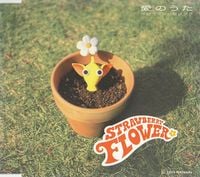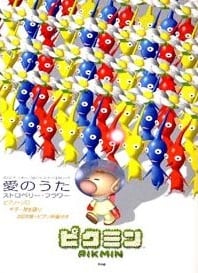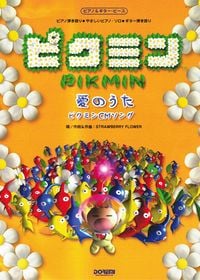Strawberry Flower: Difference between revisions
mNo edit summary |
mNo edit summary |
||
| (6 intermediate revisions by 4 users not shown) | |||
| Line 1: | Line 1: | ||
[[File:Ai no Uta.jpeg|thumb|Strawberry Flower logo as seen on the cover art | [[File:Ai no Uta.jpeg|thumb|Strawberry Flower logo as seen on the cover art for "Ai no Uta".]] | ||
'''Strawberry Flower''' | '''Strawberry Flower''' was a Japanese music duo formed by music producer Gan Matsumoto, under the alias Takeshi Tomozuma{{cite web|https://www.ganmatsumoto.com/work/ZXFpCI2d|GAN MATSUMOTO's website|his involvement with Strawberry Flower, using the alias {{j|友妻 タケシ|Tomozuma Takeshi}}|author=GAN MATSUMOTO|retrieved=27th December}} and vocalist Tomoe Watanabe{{cite web|https://diskunion.net/diw/ct/news/article/1/58031|A Japanese news article|one of the Strawberry Flower member {{j|渡辺智江|Watanabe Tomoe}}'s album|author=diskunion|published=22th April 2016|retrieved=27th December}}, mostly known for their work with [[Nintendo]] in creating songs for TV commercials for the [[Pikmin series|''Pikmin'' franchise]]. Formed in late 2001 specifically to create a song for TV advertisements for {{p1}}, they would later followed up with a few more ''Pikmin''-related single releases{{cite web|https://www.ganmatsumoto.com/series/1-4|GAN MATSUMOTO's website|his involvement with some of Strawbery Flower's Pikmin-related single releases|author=GAN MATSUMOTO|retrieved=27th December}} until 2004. Although they have been largely inactive ever since, they briefly reunited in 2015 for a single "arukuhayasade"{{cite web|https://ototoy.jp/_/default/p/49706|Ototoy's page|the single, "歩くはやさで"|author=ototoy|published=24th February 2015|retrieved=27th December}}, released independently and with no ties to ''Pikmin'' or [[Nintendo]]. | ||
== | ==History== | ||
In 2001, Nintendo enlisted composer and producer Gan Matsumoto, credited as Takeshi Tomozuma, to create music to be used in the then-upcoming {{p1}} game. Tomozuma composed the song "[[Ai no Uta]]", with Tomoe Watanabe recording the vocals. The song, was released as a single in December of 2001, alongside a B-side song, "[[Namida Ga Afureta]]", climbing to #2 in the Oricon charts in January 2002{{cite web|https://www.oricon.co.jp/prof/288453/products/465299/1/|A Oricon chart|the placement of Strawberry Flower's "Ai no Uta" single|author=ORICON NEWS|retrieved=27th December}} and selling over 600,000 copies, outselling the Japanese sales of ''Pikmin'' itself. In March 2002, a second single was released, "[[Pikmin Dance]]", featuring 3 dance versions of "Ai no Uta". The ''Pikmin'' soundtrack album, [[Pikmin World]], contains "Ai no Uta" and 2 additional remixes of it. | |||
In 2004, Nintendo commissioned Strawberry Flower for promotional ''Pikmin'' music again for TV commercials for {{p2}}; the resulting single was "[[Tane no Uta]]"{{cite web|https://www.ganmatsumoto.com/work/AqyO-ufG|GAN MATSUMOTO's website|his involvement with "Tane no Uta", also under the alias {{j|友妻 タケシ|Tomozuma Takeshi}}|author=GAN MATSUMOTO|retrieved=27th December}}. This was the last time Strawberry Flower made music for the ''Pikmin'' series. They briefly reunited in 2015 for a new single, called "arukuhayasade", being written as a tie-in to a book of the same name and is not related to the Pikmin franchise.{{cite web|https://chiisaishobo.com/arukuhayasade/|Chiisai Shobo's page|the book of the same name as the single, written by Strawberry Fruit member Gan Matsumoto|author=Chiisai Shobou|published=24th Feburary 2015|retrieved=27th December}} | |||
==Sheet music== | ==Sheet music== | ||
In light of the popularity of | In light of the popularity of Strawberry Flower's music, two different sheet music books were released containing music for ''Ai no Uta''. They were released in Japan by the publishing companies KMP on {{date|15|January|2002}} and Doremi in {{date|30|January|2002}}. The retail price for each was {{tt|¥500|≈$4.01 (at time of release)}}. | ||
===KMP=== | ===KMP=== | ||
[[File:TanenoUta SheetMusic Cover.jpg|thumb | [[File:TanenoUta SheetMusic Cover.jpg|thumb|The cover of the ''Ai no Uta'' book published by KMP.]] | ||
This book was published by KMP on {{date|15|January|2002}} and contains three different arrangements of the song: a solo piano arrangement, a guitar arrangement, and a 2-part chorus arrangement with piano accompaniment. All of the arrangements are in the song's original key (D major). Also included at the end of the book is a lyric sheet with the chords. All of the arrangements within are arranged by K. K. SMALLWOOD. The book consists of 11 pages, and its ISBN number is "ISBN 4-7732-1915-7". | This book was published by KMP on {{date|15|January|2002}} and contains three different arrangements of the song: a solo piano arrangement, a guitar arrangement, and a 2-part chorus arrangement with piano accompaniment. All of the arrangements are in the song's original key (D major). Also included at the end of the book is a lyric sheet with the chords. All of the arrangements within are arranged by K. K. SMALLWOOD. The book consists of 11 pages, and its ISBN number is "ISBN 4-7732-1915-7". | ||
| Line 38: | Line 28: | ||
===Doremi=== | ===Doremi=== | ||
[[File:AinoUta SheetMusic Cover.jpg|thumb | [[File:AinoUta SheetMusic Cover.jpg|thumb|The cover of the ''Ai no Uta'' book published by Doremi.]] | ||
This book was published by Doremi on {{date|30|January|2002}} and contains three different arrangements of the song: a solo piano arrangement (three staves, voice with piano accompaniment in the original key of D), another solo piano arrangement (simplified to the key C, this time with only two staves), and a solo guitar arrangement. Also included at the end of the book is a lyric sheet with the chords, similar to the other book. The piano arrangements are written by Shiori Aoyama and the guitar arrangement is written by Michio Tashima. The book consists of 11 pages, and its ISBN number is "ISBN 4-8108-1594-3". | This book was published by Doremi on {{date|30|January|2002}} and contains three different arrangements of the song: a solo piano arrangement (three staves, voice with piano accompaniment in the original key of D), another solo piano arrangement (simplified to the key C, this time with only two staves), and a solo guitar arrangement. Also included at the end of the book is a lyric sheet with the chords, similar to the other book. The piano arrangements are written by Shiori Aoyama and the guitar arrangement is written by Michio Tashima. The book consists of 11 pages, and its ISBN number is "ISBN 4-8108-1594-3". | ||
| Line 55: | Line 45: | ||
==See also== | ==See also== | ||
*{{w|Strawberry Flower|Wikipedia's article on Strawberry Flower}} | *{{w|Strawberry Flower|Wikipedia's article on Strawberry Flower}} | ||
{{box|This page uses content from the English Wikipedia's {{w|Strawberry Flower}} article. Text from Wikipedia is licensed under the [https://creativecommons.org/licenses/by-sa/3.0/ Creative Commons Attribution-ShareAlike 3.0 Unported] license.|750px||text-align: center;}} | |||
[[Category:Real world]] | [[Category:Real world]] | ||
Latest revision as of 19:38, December 27, 2023
Strawberry Flower was a Japanese music duo formed by music producer Gan Matsumoto, under the alias Takeshi Tomozuma[1] and vocalist Tomoe Watanabe[2], mostly known for their work with Nintendo in creating songs for TV commercials for the Pikmin franchise. Formed in late 2001 specifically to create a song for TV advertisements for Pikmin, they would later followed up with a few more Pikmin-related single releases[3] until 2004. Although they have been largely inactive ever since, they briefly reunited in 2015 for a single "arukuhayasade"[4], released independently and with no ties to Pikmin or Nintendo.
History[edit]
In 2001, Nintendo enlisted composer and producer Gan Matsumoto, credited as Takeshi Tomozuma, to create music to be used in the then-upcoming Pikmin game. Tomozuma composed the song "Ai no Uta", with Tomoe Watanabe recording the vocals. The song, was released as a single in December of 2001, alongside a B-side song, "Namida Ga Afureta", climbing to #2 in the Oricon charts in January 2002[5] and selling over 600,000 copies, outselling the Japanese sales of Pikmin itself. In March 2002, a second single was released, "Pikmin Dance", featuring 3 dance versions of "Ai no Uta". The Pikmin soundtrack album, Pikmin World, contains "Ai no Uta" and 2 additional remixes of it.
In 2004, Nintendo commissioned Strawberry Flower for promotional Pikmin music again for TV commercials for Pikmin 2; the resulting single was "Tane no Uta"[6]. This was the last time Strawberry Flower made music for the Pikmin series. They briefly reunited in 2015 for a new single, called "arukuhayasade", being written as a tie-in to a book of the same name and is not related to the Pikmin franchise.[7]
Sheet music[edit]
In light of the popularity of Strawberry Flower's music, two different sheet music books were released containing music for Ai no Uta. They were released in Japan by the publishing companies KMP on January 15th, 2002 and Doremi in January 30th, 2002. The retail price for each was ¥500.
KMP[edit]
This book was published by KMP on January 15th, 2002 and contains three different arrangements of the song: a solo piano arrangement, a guitar arrangement, and a 2-part chorus arrangement with piano accompaniment. All of the arrangements are in the song's original key (D major). Also included at the end of the book is a lyric sheet with the chords. All of the arrangements within are arranged by K. K. SMALLWOOD. The book consists of 11 pages, and its ISBN number is "ISBN 4-7732-1915-7".
The text on the cover translates to:
- CM song for the Nintendo GameCube software "Pikmin"
- Song of Love
- Strawberry Flower
- Piano Solo
- Guitar Arrangement
- 2-part Chorus with Piano Accompaniment
- Pikmin
- PIKMIN
Doremi[edit]
This book was published by Doremi on January 30th, 2002 and contains three different arrangements of the song: a solo piano arrangement (three staves, voice with piano accompaniment in the original key of D), another solo piano arrangement (simplified to the key C, this time with only two staves), and a solo guitar arrangement. Also included at the end of the book is a lyric sheet with the chords, similar to the other book. The piano arrangements are written by Shiori Aoyama and the guitar arrangement is written by Michio Tashima. The book consists of 11 pages, and its ISBN number is "ISBN 4-8108-1594-3".
The text on the cover translates to:
- Piano & Guitar Piece
- Piano playing • Easy piano solo • Guitar playing
- Pikmin
- PIKMIN
- Song of Love
- "Pikmin CM Song"
- Song / Lyrics & Composition: STRAWBERRY FLOWER
See also[edit]
|
This page uses content from the English Wikipedia's Strawberry Flower article. Text from Wikipedia is licensed under the Creative Commons Attribution-ShareAlike 3.0 Unported license. |
- ^ GAN MATSUMOTO's website on his involvement with Strawberry Flower, using the alias 友妻 タケシ?, retrieved on 27th December
- ^ A Japanese news article on one of the Strawberry Flower member 渡辺智江?'s album, published on 22th April 2016, retrieved on 27th December
- ^ GAN MATSUMOTO's website on his involvement with some of Strawbery Flower's Pikmin-related single releases, retrieved on 27th December
- ^ Ototoy's page on the single, "歩くはやさで", published on 24th February 2015, retrieved on 27th December
- ^ A Oricon chart on the placement of Strawberry Flower's "Ai no Uta" single, retrieved on 27th December
- ^ GAN MATSUMOTO's website on his involvement with "Tane no Uta", also under the alias 友妻 タケシ?, retrieved on 27th December
- ^ Chiisai Shobo's page on the book of the same name as the single, written by Strawberry Fruit member Gan Matsumoto, published on 24th Feburary 2015, retrieved on 27th December


